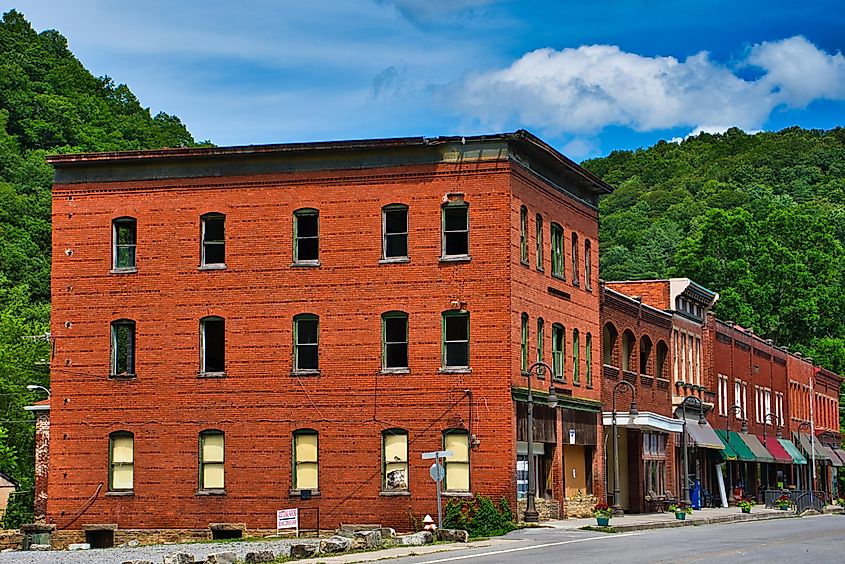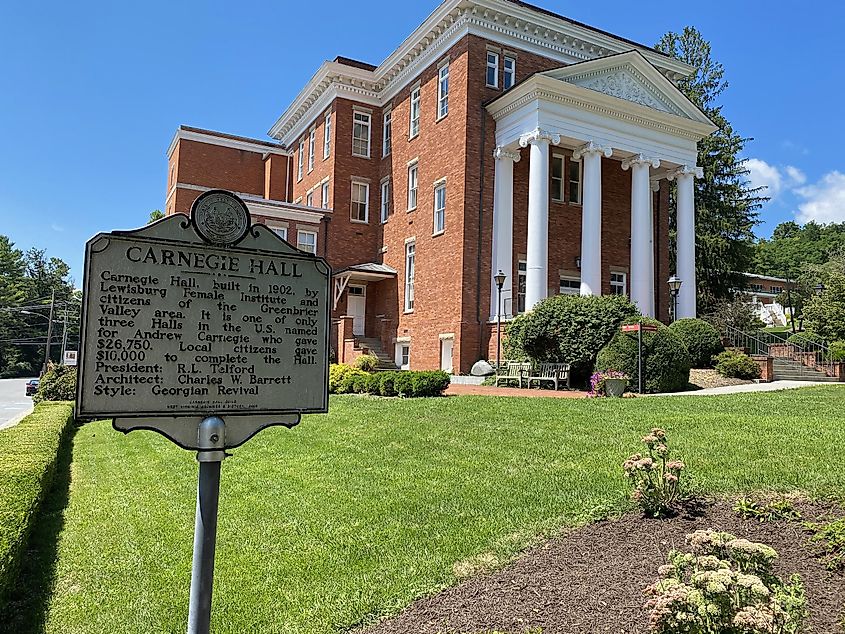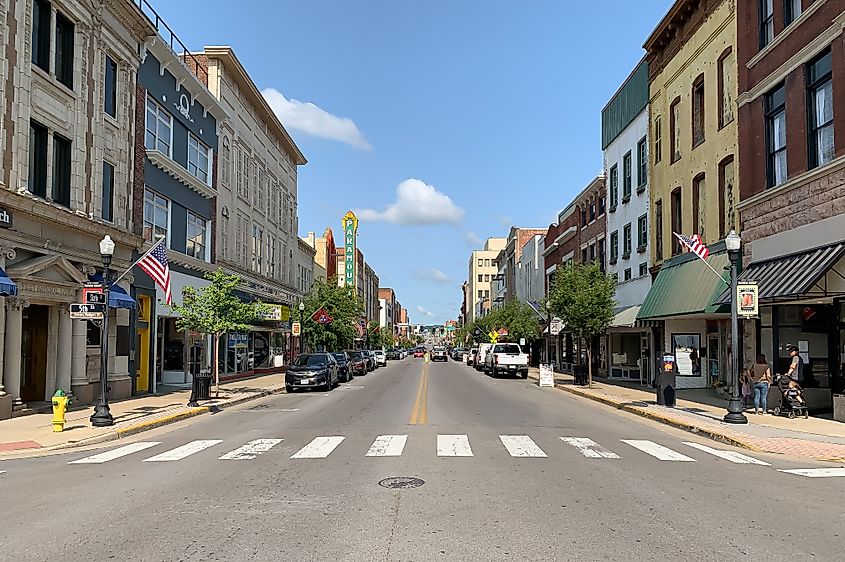
These Small Towns in the Appalachians Have the Best Historic Districts
The Appalachian Mountains, most often referred to as the Appalachians, is a historically and geographically rich mountainous range that spreads from the east and northeast parts of North America—spreading out from the Island of Newfoundland in Canada, traveling 2,050 miles downward to Alabama in the United States. Older than the Rocky Mountains, this range hits its highest peak in Mount Mitchell, located in North Carolina, with a height of 2,037 m.
This wondrous range provides unlimited opportunities and sights for any traveler, as one can enjoy the scenic views provided by the Appalachians while simultaneously learning about the rich history that makes this region so unique.
Bramwell, West Virginia

Located in Mercer County, West Virginia, and with a population of only 270 in 2022, this unassuming small town has a deep history with the coal mining industry. Between the 1870s and 1880s, the area that surrounds Bramwell began to be rapidly developed into coal fields that, by 1873, ran forty miles from its original location in modern-day Bramwell. Many of these coalfields were owned and developed by J.H. Bramwell, a New York civil engineer whose last name would later be used in the official foundation of the town in 1888.
Due to the vast wealth that was acquired in this area due to the coal fields, Bramwell is home to a multitude of enormous houses built by millionaires that used to reside in this area, including the Thomas House and Hewitt House, respectively. These impressive homes are open to the public during the Spring and Christmas seasons and include tour guides that explain the history behind both the homes and the families of the pioneers who once took up residence there. To visit these homes, one needs to take a walk down Brick Street!
Blowing Rock, North Carolina

This historic and bustling town has a total of 1,377 residents and is best known for its historic tourist industry.
Prior to the 1752 Sott-Irish settlements, Cherokee and Catawba tribes found a home in modern-day Blowing Rock. After 1752, the first family to settle in the area were the Greens, who would go on to found the historic Green Hotel in 1852. After the Civil War, modern-day Blowing Rock attracted more people due to its beautiful scenery, and the town quickly became a famous tourist spot.
Nowadays, Blowing Rock is one of the most popular destinations for folks traversing through the Appalachian Trail, and you can even book lodging in the historic Green Hotel! Of course, if you happen to visit this beautiful town, make sure you don’t miss the oldest tourist attraction in North Carolina—the Blowing Rock! This is an impressive rock formation that overlooks the stunning view of the North Carolina mountains, including Mount Mitchell!
The town also offers an array of museums, including the original 1890 home of Elliott Daingerfield, an American artist. Found on Main St., the cottage is used in the summer as part of an art program, and is open the rest of the year for daily tours.
Lewisburg, West Virginia

Located in the Greenbrier County of West Virginia with a population of 3,832 in the 2022 census, this town is definitely a must-see for history lovers that find themselves traversing the area.
Named after Andrew Lewis, a surveyor that initially founded a small camp in the area in 1751, this town would find itself at the center of some of the most crucial times in American history. During the Civil War, the town’s buildings were used as both hospitals and barracks by both the Union and Confederate sides.
Due to its rich history, the town offers many historical sites that would impress any history buff. To have a blend of both a modern and historic experience, make sure to book a stay in The Historic General Lewis Inn., which has been in operation since 1929. For a museum experience, you can also visit the Greenbrier Historical Society and North House Museum, which offers a unique look into life in Lewisburg in the 1800’s through tours of the North House, which was originally built in 1820 by Henry B. Hunter.
However, if you’re feeling more adventurous, you can book a trip into the Lost World Caverns, first discovered in 1942, and perfect for all ages to take a walk and explore different stalactites and stalagmites formations within the caverns (though make sure not to wander from the trail).
After a long day of exploring the caves, you can then wind down by catching a film in the town’s historic Lewis Theatre, which has been running since the 1930s!
Bristol, Virginia

With a population of 16,975, this town definitely is not as small as the others on this list, and is most famously known as the “Bithplace of Country Music” in the United States.
One of the first must-do things in Bristol is booking a visit to the Birthplace of Country Music Museum, which is located on the shared part of Bristol between Virginia and Tennessee and explores the history of the 1927 Bristol Sessions. These sessions are now considered by many experts to be the trigger for the explosion of Country music in the United States, and the Museum offers many different events and special exhibitions to bring the history to life.
You can also take a walk down State Street, which serves as the border between Virginia and Tennessee, where you can stand and be in two states at the same time! If you happen to get hungry, then you can take some time and visit the Original Burger Bar, most famously known as the last location where American singer Hank Williams Sr. was last seen alive!
Dahlonega, Georgia

Found at the bottom of the Blue Ridge Mountains, this town of 7,461 is the home of the first significant Gold Rush in American history that began in the area in 1829. As a result, Dahlonega emerged as a boomtown due to the different people that rushed to this area in search of gold, and remained even after the rush had ended.
One of the most popular spots to visit for history buffs is the Dahlonega Gold Museum State Historic Site, which is located within the also historic courthouse in the town square of the town. This museum offers a look into gold coins that were minted in Dahlonega during its gold rush, as well as a gold nugget that weighs 5 ounces. Aside from gold rush history, visitors can also tour the judge’s chambers as well wooden chapel seats that date back to 1889!
For a more hands-on experience, you can also visit the Crisson Gold Mine, where they teach visitors the techniques that were used to pan for gold, while also giving people the chance to try these techniques themselves. This place also offers wagon rides and showcases old-timey farm equipment, as well as different farm animals.
Berea, Kentucky

A town in Madison County, Kentucky, with a population of 15,494, the area was first settled by Europeans in the 17th century and continued expanding until it became a thriving town in the 1800s.
Berea is perhaps best known for its Berea College, which was founded in 1855 by abolitionists and is regarded nowadays as one of the most respected universities in the Southern United States. It is a historically important institution because it was the first racially integrated college in the South. While down in Berea, tourists can book student-led tours (for free), which also includes an experience of the Historic Tour.
Another must-see attraction is the historic Boone Tavern Hotel, characterized by its beautiful marble columns and Colonial-revival architecture, which was designed by J.C. Cady in 1907. This hotel has received some very important guests throughout the years, including Eleanor Roosevelt, the Dalai Lama, Henry Ford, and Maya Angelou. It is also very close to Berea College, making it the perfect stop (or stay) for a visit in Berea!
If you have time, make sure to also visit the Artisan Village, which showcases Berea’s rich history with the arts through galleries and shops, and you can even catch performances by artists, authors, and artisans in the area.
Bennington, Vermont

Bennington was first settled in 1761 by four different families that originally arrived from Hardwick and Massachusetts and is perhaps most historically significant because of the Battle of Bennington, which took place during the Revolutionary War in 1777.
During your stay, you can take a self-guided tour of Old Bennington and appreciate the unique historical buildings in the area, with the oldest home being the Jedidiah Dewey House, which was built in 1763. In the area, there is also the beautiful Old First Church, originally built in 1805 and one of the most popular tourist attractions in the town.
If you’re a fan of the writer Robert Frost, then you can’t miss a visit to the Robert Frost’s Stone House Museum, where the author lived between the years 1920-1929. The museum includes a showcase of Frost’s belongings and tells the story of his life, as well as the dining room where Frost penned "Stopping by Woods on a Snowy Evening."
In Conclusion
The Appalachian Mountains' region is an incredibly unique and beautiful landscape that also features towns that are as historically rich and diverse as the trail itself. Each town has something unique to offer anybody who happens to be traversing the Appalachian Mountains and is sure to provide an experience that will leave visitors with memories that will last them a lifetime. While undergoing such an adventurous leap in the Appalachians, it is important to remember to wind down and explore the rich history of the trail that you are exploring.











